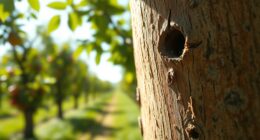Monitoring beneficial insects alongside pests helps you gauge the health of your ecosystem and guarantees effective pest control. By regularly inspecting plants, using sticky or pheromone traps, and noting beneficial activity, you can determine if natural enemies are suppressing pests or if interventions are needed. Healthy beneficial populations often mean less chemical use and better pest management. Keep paying attention, and you’ll uncover more strategies to maintain a balanced, thriving garden.
Key Takeaways
- Regularly inspect crops using visual surveys and traps to track both pest and beneficial insect populations.
- Use sticky and pheromone traps to monitor beneficial activity levels alongside pest presence.
- Observe beneficial insect behavior and abundance as indicators of natural pest control effectiveness.
- Adjust pest management strategies based on the ratio of beneficials to pests, reducing chemical use when beneficials are abundant.
- Enhance habitats with flowering plants and cover crops to attract and sustain beneficial insect populations.

Monitoring beneficial insects alongside pests is essential for effective integrated pest management. When you keep a close eye on both pests and their natural enemies, you gain valuable insight into the balance of your ecosystem. This approach allows you to make informed decisions about pest suppression strategies without over-relying on chemical controls. Biological control, which involves the use of beneficial insects like predatory beetles, parasitic wasps, and certain nematodes, can be highly effective when properly monitored. By observing the population levels of these beneficials, you can determine whether they’re actively suppressing pests or if additional interventions are necessary.
Monitoring beneficial insects helps maintain ecosystem balance and reduces reliance on chemicals for pest control.
As you monitor, pay attention to the presence and activity levels of beneficial insects. When you notice a healthy population of natural enemies, it suggests that they’re actively contributing to pest suppression. This natural pest control reduces the need for chemical pesticides, which can harm beneficials and disrupt your pest management balance. Conversely, if pest levels are rising faster than beneficial populations can control them, it’s a sign you might need to support biological control efforts. You might consider augmentative releases or habitat enhancements to promote beneficial activity.
Monitoring also helps you identify the specific types of beneficial insects present, allowing you to tailor your management strategies. For example, some parasitic wasps target aphids, while certain predatory beetles focus on caterpillars. Recognizing these relationships helps you avoid unnecessary pesticide applications that could kill beneficials, undermining pest suppression efforts. Instead, you can focus on targeted interventions that support the natural enemies already working in your field or garden.
Regular scouting is key. Use visual inspections, sticky traps, or pheromone traps to track insect populations. When you see an increase in beneficial insects, it’s often a sign that pest suppression is underway and effective. If beneficials are scarce, or if pest numbers remain high despite their presence, you may need to adjust your strategy. This might involve reducing pesticide use or providing habitat structures that attract and sustain beneficial insects, such as flowering plants or cover crops. Additionally, understanding potential pitfalls in adopting new payment technologies can help ensure that your pest management system remains secure and effective, avoiding unnecessary disruptions or vulnerabilities.
Frequently Asked Questions
How Do Beneficial Insects Impact Overall Crop Health?
Beneficial insects substantially boost your crop health by naturally controlling pests, reducing your need for pesticides. They help maintain a balanced ecosystem, but you must consider pesticide compatibility to avoid harming them. Understanding their lifecycle allows you to support their populations effectively, ensuring continuous pest control. By fostering beneficial insects, you create a sustainable environment that promotes healthier crops and minimizes chemical reliance.
What Time of Day Is Best for Monitoring Beneficials?
You should monitor beneficial insects during their activity peaks, which typically occur midday when diurnal patterns show heightened activity. This period offers the best chance to observe a variety of beneficials like ladybugs and predatory wasps. Avoid early mornings and late evenings, as activity levels decline. By timing your monitoring with these diurnal patterns, you gain more accurate insights into beneficial populations, helping you make informed pest management decisions.
Can Beneficials Control Multiple Pest Species Simultaneously?
Yes, beneficials can control multiple pest species simultaneously. By promoting species diversity, you enhance pest suppression, as different beneficials target various pests. This natural pest control decreases your reliance on chemical treatments, leading to healthier crops. To maximize this effect, guarantee a balanced ecosystem that supports a variety of beneficials, encouraging them to thrive and effectively manage multiple pest species at once.
How Do Weather Conditions Affect Beneficial Insect Activity?
Imagine a dance where weather patterns set the tempo, guiding beneficial insect activity. You’ll notice that warm, sunny days encourage insect migration and boost their movement, making them more active in controlling pests. Conversely, cooler or rainy weather tends to slow them down, reducing their effectiveness. By understanding these weather influences, you can better synchronize your pest management efforts with the natural rhythms of beneficial insects, enhancing your crop protection strategy.
What Are Common Mistakes When Identifying Beneficial Insects?
One common mistake in identifying beneficial insects is confusing them with pests, leading to beneficial insect misidentification. You might mistake a predator or pollinator for a pest due to similar appearance, which hampers pest beneficial confusion management. To avoid this, carefully observe key features like size, color, and behavior. Using reliable identification guides or consulting experts can help guarantee you correctly identify beneficials, preventing unnecessary pesticide use and supporting natural pest control.
Conclusion
By keeping a close eye on beneficials alongside pests, you sharpen your ability to maintain a healthy balance in your garden. Think of beneficial insects as silent guardians, quietly working behind the scenes to protect your plants. When you monitor both pests and beneficials, you’re not just reacting—you’re orchestrating a natural symphony of balance. This mindful approach guarantees your garden thrives, transforming it into a resilient haven where every creature plays its part.









